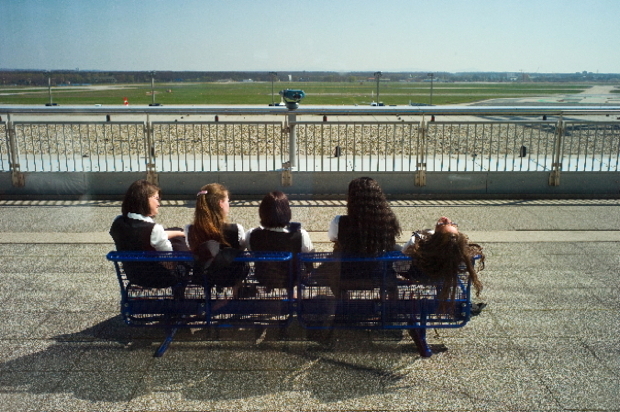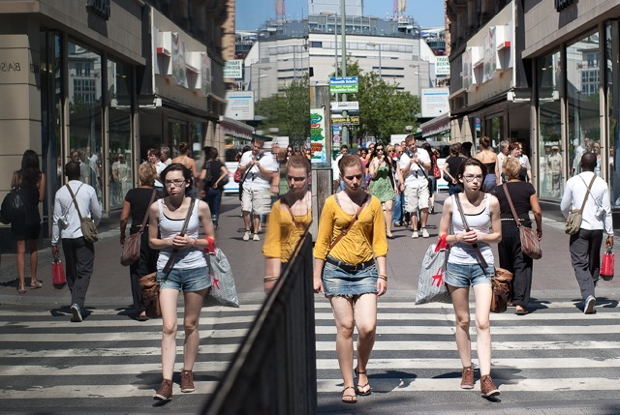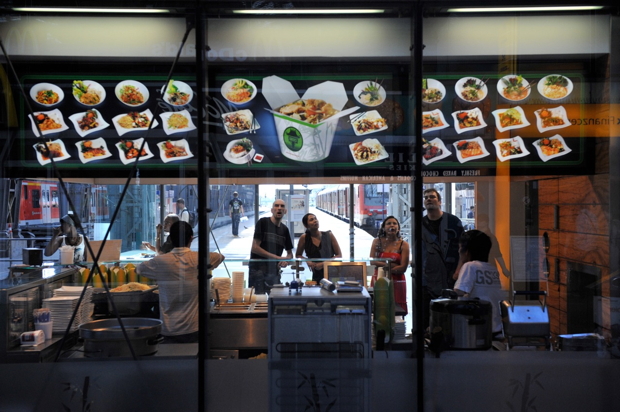Arno Rafael Minkkinen: BACK TO THE STORY
CONTEMPORARY PHOTOGRAPHY FROM FRANKFURT
A young, middle-aged people watcher, seen from behind, stares out at a floating pool parked in a harbor somewhere in Berlin. In spite of the chilly air, the woman has removed her blouse, revealing thin brown bra straps that seem to suggest that her underwear is actually her bathing suit, but the water is too cold and far away for such a plunge. The turquoise ribbon circumnavigating her straw hat, meanwhile, picks up the palette of the pool waves and distant rooftop, skylight architecture, bringing to mind that a photograph is not just about its compositional quadrants but also a journey through multi-layered planes of interest from here to infinity. In a recent article in the Arts and Entertainment Section of the Sunday New York Times, film critic Dennis Lim addresses a newfound affection among contemporary filmmakers for blurring the boundaries between documentary and fiction. A similar case could be made for the kind of photography Werner Mansholt practices, suggesting narrative impulses are always at play in the ordinary, true-to-life glimpses he hones with his carefully observant, almost directorial eye.
In another of his often-whimsical photographs, five girls of ground staff bunched on a bench—Gary Winogrand style—appear to have run out of conversation as they wait for the plane one of them seems intent to find in the sky. People at rest or in motion provide the thematic consistency in many of Mr. Mansholt’s works. Moving sidewalks and escalators become a kind of metaphor for our need to keep going even in the midst of our all-too brief moments of respite and repose.
© Werner Mansholt
German contemporary photography swept across the globe this past decade leaving behind graduate school portfolios stacked to the rafters with muted, color field typologies. Even portraits were often objectified into anonymous, plot-less facades. But August Sander, from whom likely the whole cataloging idea emerged [along with botanist Karl Blossfeldt] was a storyteller. He allowed his fields of focus to invigorate our imaginations about the unspoken storylines surrounding his subjects. The titles were the typologies; the images belonged in family albums.
If a narrative impulse is on the ascendency in documentary photography, a group of photographers working in and around Frankfurt seem to have a corner on the trend. Joachim Hildebrand’s earlier work celebrated the encyclopedic cataloguing of endless apartment dwellings in Hong Kong. These accordion-like vistas found a surprising counterpoint in a series of images of tropical fish in storefront tubs, packed like sardines swimming nowhere. The combined typologies, however, indicated no storylines as such.
© Joachim Hildebrand
In his recent work, however, the narrative impulse steps in dramatically, turning up the volume on contemporary photography. Shooting down from shopping mall overpasses, without the graphic intent of the 30’s Bauhaus masters such as Moholy-Nagy and Otto Steinert, Mr. Hildebrand catches streams of crisscrossing populations coming and going from who knows where to who knows where. In one close-up frame, he isolates two teenaged sisters perhaps, seated on a rising escalator. We can tell the direction they are going by the inter-racial couple just above them. [His fingers on the small of her back is a stolen moment, the kind photographs of which there are millions that we, ourselves, never see!] What Mr. Hildebrand’s slice of escalator image reveals, of course, is the length of the upward journey. Who sits on escalators to begin with? Certainly you wouldn’t park your butt down like that for a short haul. A myriad of stories are built into the picture frame. Shopping without shopping bags gives the economic side, who has money? Below the teenagers a single guy checks out his cell phone, bringing in yet another human dimension. The visual cues are all at work: the dress of the younger sibling echoes the escalator stairs; the hand clicking the phone is not unlike the massage being sent to the small of the woman’s back. The conversation, or lack thereof, among the sisters, grabs our attention most. Both siblings reflect on what the other may just have said. They are adrift in a sea of unknown anonymity. The volume, in this case, is the hum of the machinery moving them through this snippet of adolescence.
© Günter Stiegler
Guenter Stiegler utilizes storefront window glass reflections to clone his unknowing subjects. It is the moment of their separation from themselves that gives the images their urgency. Watching the duplication, we can’t help seeing ourselves split apart as well. It is in the repetition of the concept that the photographs begin to work: the glass saw slicing us all down the center.
© Thomas Duhnkrack
The stage itself becomes part of the story. Thomas Duhnkrack constructs perfect dioramas wherein his subjects find their places almost as if they had been dropped in like puppets. Life is like that Mr. Duhnkrack seems to suggest. We go about our lives much the same way every day, searching the menu boards for the specials of the week or in more dramatic fashion, searching for one thing or another as we saddle up for the next adventure. Where those five amigos on motorcycles are headed even they might not remember, but we can hear the tourist bus off-screen impatiently beeping its horn.
Photography’s fascination with typological still life shifts to an interest in the act of living itself. It’s not the street photography of the fifties as Henri Cartier-Bresson and Robert Frank saw it as much as it is a reassessment of the world the 20th century has created and left us to grapple with. That much, at least, seems to be what is visible from this corner of Germany.
2010 © Arno Rafael Minkkinen
(Professor, University of Massachusetts Lowell, USA/Aalto University of Art & Design Helsinki, Finland)




